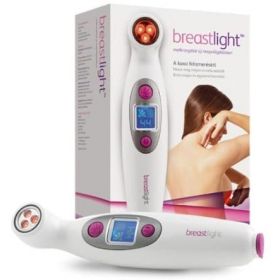Product Categories
Most popular
ABOUT BREASTLIGHT™

Breastlight – a novel mode of looking at breast cancer with a significant potential and an example of alternative approaches to research
Jayant S Vaidya, Mangesh Thorat
There is currently no effective screening tool for breast cancer in young women. Mammography is not sensitive enough and MRI may be too sensitive and expensive; and both cannot be used very frequently in this cohort in whom cancers may grow quickly.
Breastlight is a handheld device that transilluminates the breast with a red light (617nm) that is absorbed by haemoglobin so that areas of high vascularity (such as malignant tumours) should appear black. Clinical trials with its prototype in Edinburgh and Aberdeen had a sensitivity of 70-90%. With miniaturisation technology, the principles have been used to manufacture a handheld device. Data collected by an independent market research company employed by manufacturers are presented here.
Of the 1500 women approached, 1087 returned their feedback. 543 were < 50 yrs old and 511 were pre menopausal. 78% found Breastlight easy to use. 14 women (1.3%) were prompted to go and see a doctor based on new findings; of these, 3 had a mammogram and 1 cancer (non-palpable 1.2 cm) was detected. 80% of women felt a little more or a lot more confident about finding abnormalities in their own breasts after using the device. All women would still attend a routine mammogram and they were not dissuaded by the reassurance of normal findings with device. 1/1087 said that she would request an appointment for a mammogram and 2/1087 said that they would visit a doctor more frequently.
The device appears unlikely to do harm either by raising anxiety or by giving false reassurance. The device needs to be investigated further especially in certain groups of women: those with a family history of breast cancer, lumpy breasts, recurrent cysts and those under 50, in whom screening mammography is relatively ineffective. If its sensitivity and specificity is found to be acceptable, it could be investigated whether it is effective as a screening tool that could potentially be used frequently by women themselves.
Breastlight™ clinical trial results
Published trials on Breastlight (Edinburgh & Aberdeen), using an earlier device, demonstrate that light-based technology can deliver high sensitivity levels (82%) in lesions over 1.5cm and useful levels (29%) in non palpable lesions.
Summary of consolidated results
|
Malignant tumours |
Detected by device |
Confirmed by biopsy |
Detection rate % |
|
Total |
139 |
169 |
82% |
|
> 2cm |
95 |
106 |
90% |
|
< 2 cm |
23 |
31 |
74% |
|
Non palpable |
4 |
14 |
29% |
|
Not measured |
17 |
18 |
94% |
Background
Earlier studies have shown that breast cancer can be demonstrated by transmission of light through the tissues (1,2). Optical images of cancer arise principally because of the associated angiogenesis.
Initial studies on the breast illumination method using earlier versions of the Breastlight device were carried out in the Edinburgh Royal Infirmary and the University of Aberdeen.
Results
The Edinburgh study (3) included a total of 129 patients with palpable lesions. Of these:
- 74 patients had confirmed tumours
- 55 patients had cysts or other benign disease.
Detection rates with the device were:
|
Diagnosis |
No diagnosed |
Detected by device |
% |
|
Confirmed tumours |
74 |
70 |
94.6% |
|
Benign disease |
55 |
50 |
90.9% |
False positive declarations were made on patients with blood filled cysts and abscesses.
In 56 of the patients the size of the lesions was estimated by the use of callipers. Detection rates with the device were:
| Lesion size |
No of patients |
Detected by device |
% |
|
>2cm |
38 |
38 |
100% |
|
< 2 cm |
15 |
18 |
83.3% |
The Aberdeen (4) study involved 178 patients. Of these:
- 69 had normal mammograms
- 109 had abnormalities detected by mammography
Of the latter, 95 had confirmed breast cancer:
- The device detected 69 of the tumours (72%)
- Of those not detected, 8 were ductal carcinomas in situ; average size of cancers missed was 1.1cm
Detection rates by size of tumour amongst the 95 patients were:
|
Tumour size |
No of patients |
Detected by device |
% |
|
>2cm |
68 |
57 |
83.8% |
|
<2cm |
13 |
8 |
61.5% |
|
Non palpable |
14 |
4 |
28.6% |
Of the 83 patients where no cancer was present, device detection rates were compared with mammography:
|
Method |
Detected by device |
% |
|
Optical device |
68/83 |
81.9% |
|
Mammogram |
69/83 |
83.1% |
LARGE SCALE USER EVALUATION
In July 2008 PWB Health commissioned an independent market research company to carry out a large scale study on Breastlight usage.
The objectives of the study were to assess how Breastlight was used, how it affected women's attitude to breast awareness and breast screening and to give an indication of the frequency of referrals.
The results - 1087 women
Breastlight was well received and understood
- 78% of women said Breastlight was easy to use
- Breastlight was clearly seen by women (over 99%) as an addition to their current breast awareness & screening routines rather than a substitute
Breastlight encouraged more frequent breast awareness
- After using Breastlight, regular checkers (once a month and more) increased from 44% to 76%
- After using Breastlight, less frequent and non - checkers decreased fom 34% to 8%
Breastlight improved women's confidence in self checking
- 80% were more confident after using Breastlight
Breastlight was particularly valued by certain groups
- Women 30 - 49 who are not having regular mammograms
- Women with lumpy breasts
- Women with large breasts
Of the 1087 women, 14 (1.3%) consulted a GP because they were concerned
Of these, three have had mammograms and one was subsequently diagnosed with early stage breast cancer. She has had an operation and is recovering well.
The outcome of the mammograms for the two other women is awaited.
BREASTLIGHT VIDEOS
Please click the screen below to watch the Web TV broadcast.
This text will be replaced








